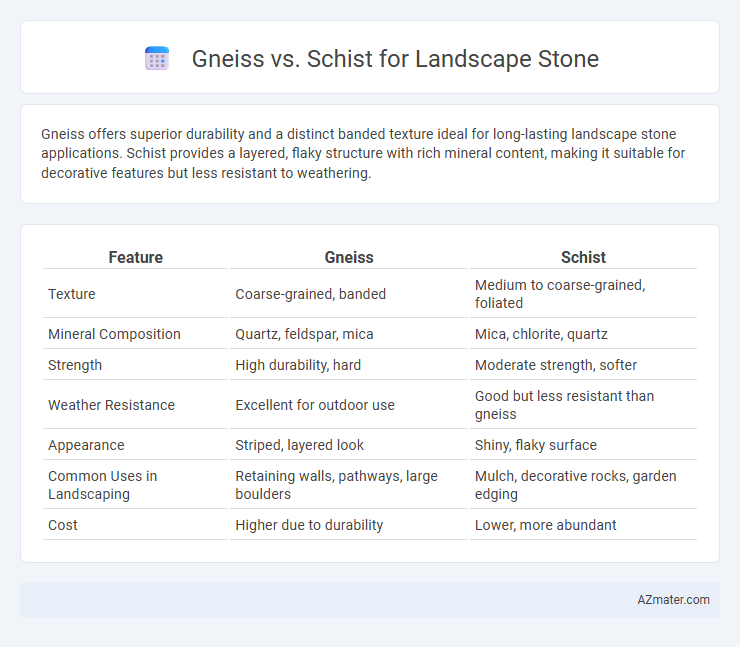Gneiss offers superior durability and a distinct banded texture ideal for long-lasting landscape stone applications. Schist provides a layered, flaky structure with rich mineral content, making it suitable for decorative features but less resistant to weathering.
Table of Comparison
| Feature | Gneiss | Schist |
|---|---|---|
| Texture | Coarse-grained, banded | Medium to coarse-grained, foliated |
| Mineral Composition | Quartz, feldspar, mica | Mica, chlorite, quartz |
| Strength | High durability, hard | Moderate strength, softer |
| Weather Resistance | Excellent for outdoor use | Good but less resistant than gneiss |
| Appearance | Striped, layered look | Shiny, flaky surface |
| Common Uses in Landscaping | Retaining walls, pathways, large boulders | Mulch, decorative rocks, garden edging |
| Cost | Higher due to durability | Lower, more abundant |
Introduction to Gneiss and Schist
Gneiss and Schist are both metamorphic rocks commonly used as landscape stones, each exhibiting distinct textures and mineral compositions. Gneiss features a banded or foliated structure with alternating light and dark mineral layers, providing a durable and visually striking option for outdoor applications. Schist is characterized by its pronounced platy minerals and schistosity, offering a more flaky and layered appearance suited for decorative pathways and garden accents.
Geological Formation and Composition
Gneiss is a metamorphic rock characterized by its banded texture formed through high-grade regional metamorphism of granite or sedimentary rocks, composed mainly of quartz, feldspar, and mica. Schist, also a metamorphic rock, develops under medium to high-grade metamorphic conditions with pronounced foliation, dominated by platy minerals like mica and chlorite, giving it a layered appearance. The mineral composition and formation conditions of gneiss provide a more durable, coarse-grained stone ideal for rugged landscapes, while schist's foliated structure offers aesthetic appeal with its shimmer and texture in decorative landscaping.
Physical Appearance and Texture
Gneiss features a banded or foliated texture with alternating layers of light and dark minerals, creating a striking, striped appearance that enhances landscape stone design. Schist exhibits a more pronounced, flaky texture due to its high mica content, resulting in a shimmering surface that adds depth and visual interest to outdoor spaces. Both stones provide unique aesthetic qualities, with gneiss offering a more structured look and schist presenting a softer, more intricate texture for diverse landscaping applications.
Durability and Weather Resistance
Gneiss offers superior durability and weather resistance compared to schist, making it ideal for landscape stone applications exposed to harsh environmental conditions. Its coarse-grained, foliated structure withstands freeze-thaw cycles and erosion better than schist, which tends to be more prone to splitting and scaling due to its finer, platy mineral composition. Gneiss's high quartz and feldspar content contributes to its hardness and resistance to chemical weathering, ensuring long-lasting performance in patios, retaining walls, and walkways.
Color Variations and Aesthetic Appeal
Gneiss exhibits a banded or foliated texture with color variations ranging from gray and pink to black, offering a sophisticated and elegant appearance ideal for modern landscape designs. Schist features a more pronounced flaky or scaly texture with colors including silver, green, and brown, providing a rustic and natural aesthetic that complements woodland or cottage-style gardens. The choice between gneiss and schist depends on the desired visual impact and color palette, with gneiss favoring sleek, structured looks and schist enhancing textured, organic landscapes.
Installation and Workability
Gneiss offers superior durability and density, making it more challenging to cut and shape during installation compared to the more easily worked and layered Schist. Schist's foliated texture enables simpler splitting and custom shaping, which reduces labor time but can compromise long-term stability under heavy loads. Choosing Gneiss for landscape stone provides enhanced structural integrity, whereas Schist favors quicker installation and detailed aesthetic designs.
Cost Comparison: Gneiss vs Schist
Gneiss typically costs more than schist per ton due to its higher density and durability, making it a premium choice for long-lasting landscape stone. Schist is generally more affordable, offering aesthetic appeal with its foliated texture but may require more maintenance over time. Cost differences between gneiss and schist also depend on availability and quarry location, influencing transportation expenses.
Best Landscaping Applications
Gneiss offers a durable and visually striking option for landscape stone, excelling in retaining walls, pathways, and decorative boulders due to its strong foliated structure and unique banded appearance. Schist, characterized by its layered texture and mica content, is ideal for garden accents, stepping stones, and water features, providing a natural shimmer and ease of splitting into thin slabs. Both stones enhance outdoor aesthetics, but gneiss's toughness suits high-traffic areas while schist is preferred for ornamental touches and softer landscaping designs.
Maintenance and Longevity
Gneiss offers superior durability and low maintenance due to its coarse-grained texture and high resistance to weathering, making it ideal for long-lasting landscape stone applications. Schist, characterized by its foliated texture, tends to be softer and more prone to flaking, requiring more frequent upkeep and sealing to maintain appearance and structural integrity. Both stones provide aesthetic value, but gneiss outperforms schist in longevity and ease of maintenance in outdoor environments.
Environmental Impact and Sustainability
Gneiss and schist, both metamorphic rocks, offer durable options for landscape stone with varying environmental impacts. Gneiss, typically quarried with less processing and exhibiting higher density, tends to have a lower carbon footprint compared to schist, which often requires additional splitting due to its foliated structure, increasing energy use. Choosing locally sourced gneiss or schist reduces transportation emissions, while their natural durability supports sustainability by minimizing the need for frequent replacement in outdoor landscaping.

Infographic: Gneiss vs Schist for Landscape Stone
 azmater.com
azmater.com